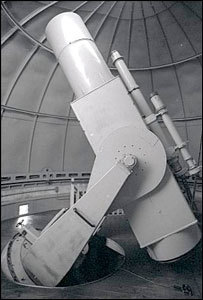
|
| ©BBC |
| The cost of installing the telescope is estimated at £54,000 |
OF THE
TIMES
It was a warm, clear afternoon in the capital. The bustle of metropolitan commerce and tourism filled the streets. Small sailing vessels dotted the sheltered waters within sight of the government buildings, riding on a soft southerly breeze. The Sun sparkled on the gentle swells and wakes, lending a luminous glow to the poppies and tulips nodding in the parks along the water's edge. All was in order.
But suddenly, the sky brightened as if with a second, more brilliant Sun. A second set of shadows appeared; at first long and faint, they shortened and sharpened rapidly. A strange hissing, humming sound seemed to come from everywhere at once. Thousands craned their necks and looked upwards, searching the sky for the new Sun. Above them a tremendous white fireball blossomed, like the unfolding of a vast paper flower, but now blindingly bright. For several seconds the fierce fireball dominated the sky, shaming the Sun. The sky burned white-hot, then slowly faded through yellow and orange to a glowering copper-red. The awful hissing ceased. The onlookers, blinded by the flash, burned by its searing heat, covered their eyes and cringed in terror. Occupants of offices and apartments rushed to their windows, searching the sky for the source of the brilliant flare that had lit their rooms. A great blanket of turbulent, coppery cloud filled half the sky overhead. For a dozen heartbeats the city was awestruck, numbed and silent.

|
| ©Unknown |
| An artist's reconstruction of Josephoartigasia monesi (top) is superimposed on an image of the prehistoric rodent's skull. A sculpture (below) further fleshes out the South American mammal. (See more pictures of the giant rodent - and its nearest living cousin.) |
Comment: Continue to Part Five: Thirty Years of Cults and Comets